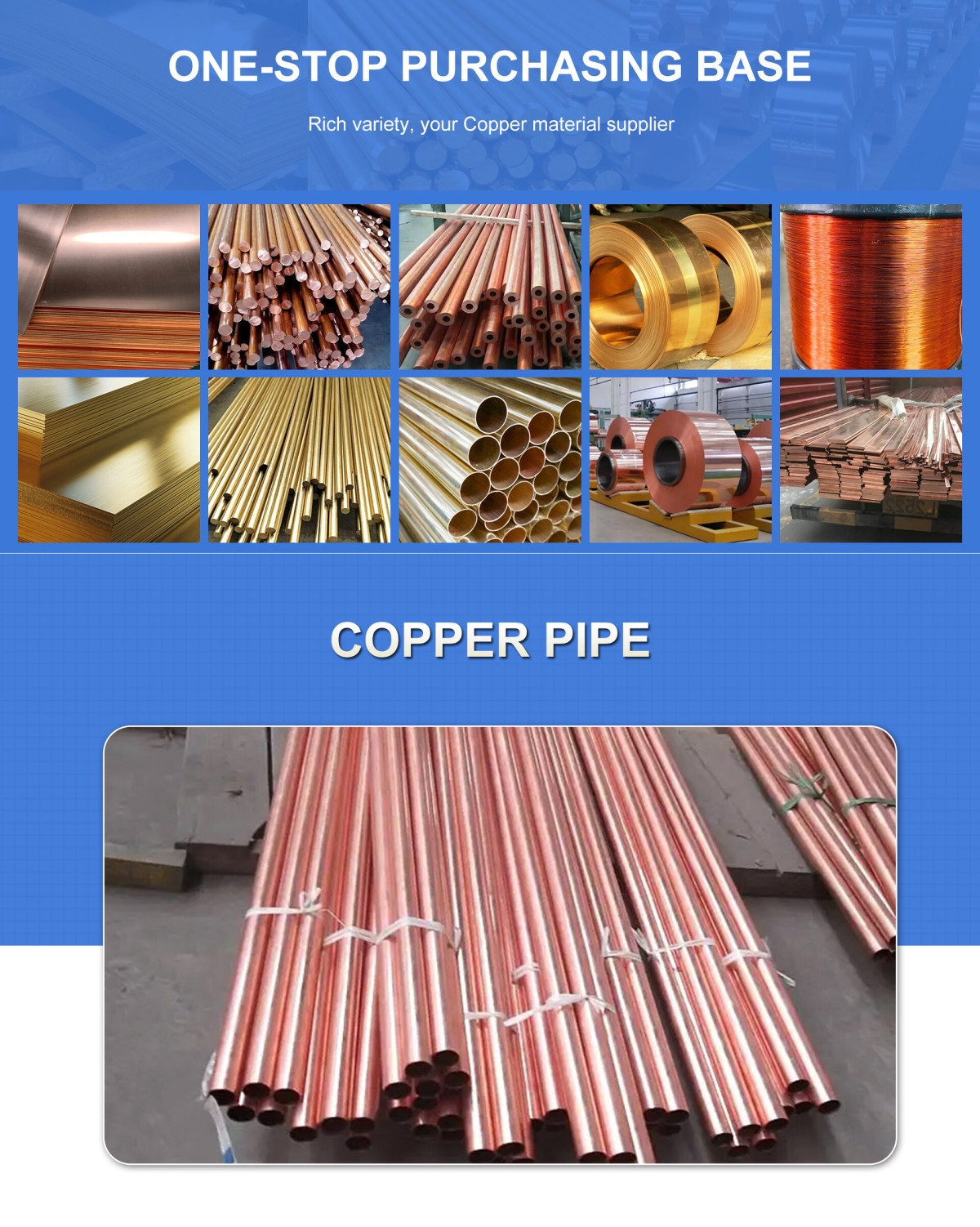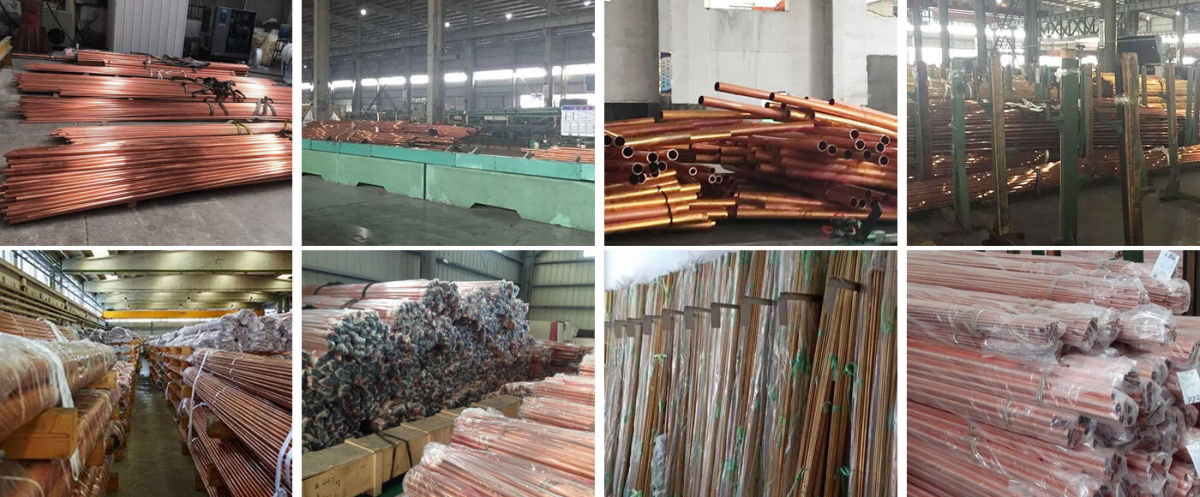
Size range
Outer diameter (OD): The standard range is usually 5-100 mm, and the common international standard specifications are concentrated in 8-76 mm (such as ASTM B111 stipulates ≤80 mm).
Wall thickness (WT): 0.5-25 mm, but the common wall thickness of heat exchangers is 0.5-6 mm, and higher thickness can be customized.
Length: Support single random length (5-7 meters), double random length or customized according to customer needs.
III. International standards
Core standards:
ASTM B111/B111M: The main standard for seamless copper alloy pipes, covering size, chemical composition and mechanical properties.
ASME SB111: Applicable to pressure vessels and boiler equipment.
BS EN 12451/BS 2871-2: European standard, compatible with ASTM.
JIS H3300/DIN 1785: Japanese and German standards, applicable to corresponding markets.
Other related standards:
ASTM B395 (welded pipe), ASTM B251 (general purpose pipe).
API 11AX: Supplementary requirements for oil and gas applications.
Copper (Cu): 69.0% - 73.0% (most literature supports 69.0% - 71.0%, but some standards such as EN give 70.0% - 73.0%).
Tin (Sn): 0.8% - 1.3%, used to enhance corrosion resistance.
Zinc (Zn): Balance, usually 25% - 29%.
Arsenic (As): 0.02% - 0.06%, inhibits dezincification corrosion.
Impurities: Lead (Pb) ≤ 0.05%, Iron (Fe) ≤ 0.10%, Nickel (Ni) ≤ 0.5%, Total impurities ≤ 0.3%.
Physical Properties
Density: 8.53 g/cm³ (most sources), 8.3 g/cm³ in some sources.
Melting Point: Liquidus 940°C (1720°F), Solidus 900°C (1650°F).
Thermal Conductivity: 64 - 110 W/m·K.
Electrical Conductivity: 25% - 28% IACS (International Annealed Copper Standard).

C44300 copper tube (naval brass) is a copper-zinc alloy tube widely used in marine engineering, heat exchangers and petrochemical fields. Its production process and product advantages are as follows:
1. Production process
Smelting and continuous casting
The raw materials (cathode copper, phosphor copper alloy, etc.) are melted at 1200℃ in an industrial frequency furnace and formed into copper tube blanks through a horizontal continuous casting process. Waste emulsion and copper scraps are generated in this stage and need to be recycled.
Rolling and stretching
Planetary rolling: Long-stroke tube rolling mill is used to improve dimensional accuracy and reduce eccentricity.
Stretching process: Patented technologies such as "floating extrusion die" and "universal stretching die" are applied, combined with floating core head stretching technology to ensure smooth inner and outer surfaces of the tube and precise dimensions. High-speed tandem drawing machine can improve efficiency.
Annealing and forming
The mesh chain bright annealing technology is used to eliminate processing stress and keep the surface free of oxidation spots. It is subsequently formed through bending, welding and other processes, and the welding needs to control smoke pollution.
Surface treatment and testing
Cleaning: Use a grinding disc, sandpaper or sandblasting to clean the surface.
Testing: Including eddy current test, intergranular corrosion test and spectral analysis, etc., to ensure compliance with ASTM B111 and other standards.
2. Product advantages
Excellent corrosion resistance
Adding arsenic (0.4%) inhibits dezincification corrosion, suitable for seawater, fresh water and sulfide-containing environments.
It performs well in marine cooling systems and desalination equipment, with a service life of more than 10 years.
High thermal conductivity and mechanical properties
Thermal conductivity is 109 W/(m·K), suitable for efficient heat transfer scenarios such as heat exchangers and condensers.
Tensile strength ≥330 MPa, elongation ≥40%, with both high strength and processing plasticity.
Processing convenience
It can be formed by rolling, stamping and bending, and supports threaded connection and welding.
Excellent cold processing performance, suitable for complex structure manufacturing.
Standardization and environmental protection
Complies with international standards such as ASTM B111, ASME SB466, and adapts to global industrial needs.
Recycling of waste materials (copper chips, emulsion) in the production process reduces environmental impact.
Wide application
Applicable to ship heat exchangers, oil pump pipes, chemical equipment and building HVAC systems, with both pressure resistance and wear resistance.
Q1:Do you provide samples? Is it free or extra?
A1:Yes, we can provide samples free of charge and the customer will pay the freight.
Q2:What if I don't have export experience ?
A2:We have reliable forwarder agent which can ship items to you by sea/air/Express to your doorstep. Any way, we will help you choose the most suitable shipping service.
Q3:How long is your lead time?
A3:If it is in stock, it is usually 5-10 days. Or, if there is no inventory, 15 days, depending on the quantity.
Q4:What are your terms of payment?
A4:30% T/T deposit in advance, 70% T/T balance within 5 days after B/L copy, 100%.Irrevocable L/C at sight, 100% Irrevocable L/C after receive B/L 30-120 days, O/A.
Q5:How is your technical support?
A5:We provide lifetime online support through Whatsapp/ Skype/ Wechat/ Email. Any problem after delivery, we will offer you call anytime.
Welcome To Your Inquiry
What can we help you?
RELATED PRODUCTS











